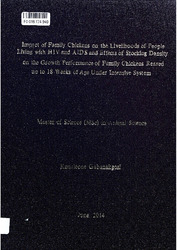| dc.description.abstract | Two studies were carried out to investigate the impact of family chicken component of BONEPWA+ on the livelihoods of people living with HIV and AIDS (PLWHA). In the first study, the impact of family chickens on the livelihoods of PLWHA was investigated in Khudumelapye, Mogobane, Mokubilo and Serowe villages of Botswana. The objectives of this study were to determine the consumption and marketing of family chickens and to evaluate the contribution of family chickens towards household income and nutrition of PLWHA in four villages. Data were collected from 100 respondents (25 from each village) using a structured questionnaire and through direct observation. The data was analysed using SPSS. The results showed that 79% of the respondents slaughtered chickens for family consumption and 21% to honour guests. Sixty-one percent of respondents consumed eggs while the remainder used eggs for breeding purposes. Seventy-four percent of the respondents sold some chickens to meet immediate family needs. Eighty-two percent of chickens were sold for cash followed by barter (10%). A total of 874 chickens were sold from the surveyed villages earning the sum of P18, 030.00 (2253.75USD). The average price of a chicken was P57.50 (7.19USD). Family chickens were mainly used for consumption and also sold to meet family needs, thus contributing to improved household income and nutrition of PLWHA. In order to increase the benefits of rearing family chickens, the rearers should be trained in general poultry management. In addition, the rearers should be encouraged to form associations which will assist in marketing chickens.
In the second study, a total of 248 day old chicks were randomly assigned to four stocking densities D1, D2, D3 and D4 being 10 birds/m2, 13 birds/m2, 16 birds/m2 and 19 birds/m2 in the first phase (0-6 weeks); 8 birds/m2, 11 birds/m2, 14 birds/m2 and 17 birds/m2 in the second phase (7-12 weeks) and lastly 6 birds/m*, 9 birds/m*, 12 birds/m* and 15 birds/m* in the third phase (13-18 weeks) due to slaughtering which was done at the end of each phase in a completely randomized design. Birds were raised under intensive system in a lm2 pen and given commercial diets fed at ad libitum. The number of replicates per treatment was four. Parameters recorded included feed intake, body weight (BW), body weight gain (BWG), feed conversion ratio (FCR), mortality, final live weight, dressed weight and dressing percentage. Dnta were analysed using the General Linear Model Procedures in Statistical Analysis System. The growth parameters (feed intake. BW, BWG. FCR, mortality, final live weight, dressed weight and dressing percentage) of family chickens reared in three phases under intensive system were not significantly (P<0.05) affected by different stocking densities because of slaughtering which was done at six weekly intervals. A significant stocking density and age interaction occurred for feed intake (P<0.0002) and (P<0.0001) in the first phase and third phase, respectively indicating that the interaction of stocking density and age did affect feed intake. The optimum stocking density for family chickens under intensive system of management should be approximately 10 birds/m2 because family chickens performed well under the stocking density. | en_US |

